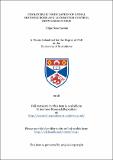Files in this item
Cholinergic modulation of spinal motoneurons and locomotor control networks in mice
Item metadata
| dc.contributor.advisor | Miles, Gareth Brian | |
| dc.contributor.author | Nascimento, Filipe | |
| dc.coverage.spatial | 211 p. | en_US |
| dc.date.accessioned | 2018-10-04T09:01:49Z | |
| dc.date.available | 2018-10-04T09:01:49Z | |
| dc.date.issued | 2018-12-06 | |
| dc.identifier.uri | https://hdl.handle.net/10023/16141 | |
| dc.description.abstract | Locomotion is an innate behaviour that is controlled by different areas of the central nervous system, which allow for effectiveness of movement. The spinal cord is an important centre involved in the generation and maintenance of rhythmic patterns of locomotor activity such as walking and running. Interneurons throughout the ventral horn of the spinal cord form the locomotor central pattern generator (CPG) circuit, which produces rhythmic activity responsible for hindlimb movement. Motoneurons within the lumbar region of the spinal cord innervate the leg muscles to convey rhythmic CPG output to drive appropriate muscle contractions. Intrinsic modulators, such as acetylcholine acting via M2 and M3 muscarinic receptors, regulate CPG circuitry to allow for flexibility of motor output. Using electrophysiology and genetic techniques, this work characterized the receptors involved in cholinergic modulation of locomotor networks and the role and mechanism of action of a subpopulation of genetically identified cholinergic interneurons in the lumbar region of the neonatal mouse spinal cord. Firstly, the effects of M2 and M3 muscarinic receptors on the output of the lumbar locomotor network were characterised. Experiments in which fictive locomotor output was recorded from the ventral roots of isolated spinal cord preparations revealed that M3 muscarinic receptors are important in stabilizing the locomotor rhythm while M2 muscarinic receptor activation seems to increase the irregularity of the locomotor frequency whilst increasing the strength of the motor output. This work then explored the cellular mechanisms through which M2 and M3 muscarinic receptors modulate motoneuron output. M2 and M3 receptor activation exhibited contrasting effects on motoneuron function suggesting that there is a fine balance between the activation of these two receptor subtypes. M2 receptor activation induces an outward current and decreases synaptic drive to motoneurons while M3 receptors are responsible for an inward current and increase in synaptic inputs to motoneurons. Despite the different effects of M2 and M3 receptor activation on synaptic drive and subthreshold properties of MNs, both M2 and M3 receptors are required for muscarine-induced increase in motoneuron output. CPG networks therefore appear to be subject to balanced cholinergic modulation mediated by M2 and M3 receptors, with the M2 subtype also being important for regulating the intensity of motor output. Next, using Designer Receptor Exclusively Activated by Designer Drug (DREADD) technology, the impact of the activation or inhibition of a genetically identified group of cholinergic spinal interneurons that express the Paired-like homeodomain 2 (Pitx2) transcription factor was explored. Stimulation of these interneurons increased motoneuron output through the activation of M2 muscarinic receptors and subsequent modulation of Kv2.1 channels. Inhibition of Pitx2⁺ interneurons during fictive locomotion decreased the amplitude of locomotor bursting. Genetic ablation of these cells confirmed that Pitx2⁺ interneurons increase the strength of locomotor output by activating M2 muscarinic receptors. Overall, this work provides new insights into the receptors and mechanisms involved in intraspinal cholinergic modulation. Furthermore, this study provides direct evidence of the mechanism through which Pitx2⁺ interneurons regulate motor output. This work is not only important for advancing understanding of locomotor networks that control hindlimb locomotion, but also for dysfunction and diseases where the cholinergic system is impaired such as Spinal Cord Injury and Amyotrophic Lateral Sclerosis. | en_US |
| dc.language.iso | en | en_US |
| dc.publisher | University of St Andrews | |
| dc.subject | Locomotion | en_US |
| dc.subject | Spinal cord | en_US |
| dc.subject | Central pattern generator | en_US |
| dc.subject | Muscarinic receptors | en_US |
| dc.subject | Motoneurons | en_US |
| dc.subject.lcc | QP369.5N2 | |
| dc.subject.lcsh | Motor neurons | en |
| dc.subject.lcsh | Muscarinic receptors | en |
| dc.subject.lcsh | Cholinergic mechanisms | en |
| dc.subject.lcsh | Locomotion--Regulation | en |
| dc.title | Cholinergic modulation of spinal motoneurons and locomotor control networks in mice | en_US |
| dc.type | Thesis | en_US |
| dc.contributor.sponsor | Alfred Dunhill Links Foundation | en_US |
| dc.type.qualificationlevel | Doctoral | en_US |
| dc.type.qualificationname | PhD Doctor of Philosophy | en_US |
| dc.publisher.institution | The University of St Andrews | en_US |
This item appears in the following Collection(s)
Items in the St Andrews Research Repository are protected by copyright, with all rights reserved, unless otherwise indicated.

